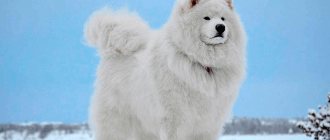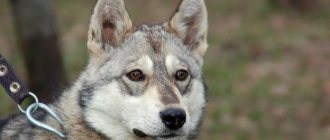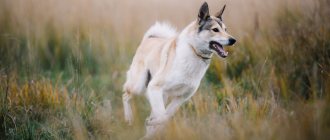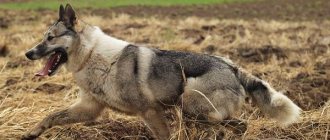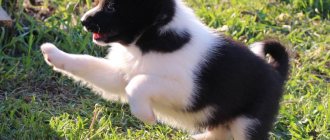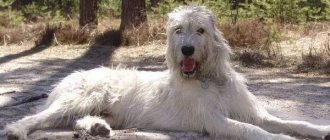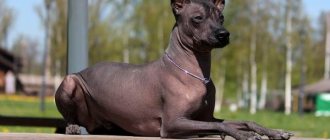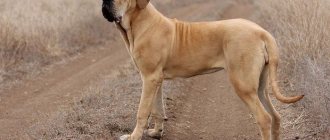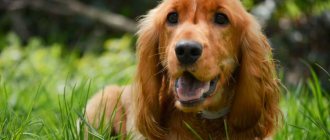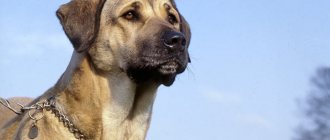The Samoyed dog is a very interesting breed. It is so unusual that even the names Samoyed Laika or Arctic Spitz used in the scientific community cannot fully reflect all its characteristic features. Magnificent thick fluffy white coat with a soft undercoat and stiffer outer hair (a typical polar explorer), slanted, very intelligent, even with some cunning eyes and a comprehensive love for all living things, which manifests itself every minute - these are the integral features of this magnificent representative of the canine family. Maximum attention, admiration and delight are guaranteed to any owner of the inimitable Samoyed!
History of the Samoyed dog breed
Samoyed
Researchers believe that Samoyed huskies have been living next to humans for about three thousand years, and in an almost unchanged form, since their habitat is limited, and mixing with other dogs was impossible for objective reasons.
The breed got its name from the name of the nomadic tribes of the northern regions of the Urals and Siberia, now known as the Nenets. These peoples lived separately from the surrounding world and were self-sufficient, “self-unified” - hence the name. There is no need to look for any “gastronomic” subtext in the word “Samoyed”.
From these parts, at the end of the 19th century, the British zoologist and dog lover Ernst Kilburn-Scott brought several remarkable dogs to London. Among them was a very large snow-white male named Masti. It was from this period that the modern history of the breed began. In 1909, Scott and his wife opened the still famous Farmingham kennel, and a couple of years later the first club for lovers of unusual northern dogs appeared. At the same time, a standard was defined that has existed unchanged for more than a hundred years. The breed quickly gained wide popularity, and already in the thirties of the last century, nurseries for breeding Samoyeds appeared in continental Europe. Such attention of breeders to preserving the species played a positive role. The fact is that the development of civilization has led to irreversible consequences: even in its original habitat, in the Far North, it is very problematic to meet a purebred Samoyed aborigine. In its original form, the breed was preserved in Western nurseries, from where it began its return to its historical homeland - Russia. Today the number of Samoyeds in our country is 2-3 thousand individuals.
Samoyed puppy with momPossible diseases
With proper care and competent care, Samoyeds can live up to 15-16 years, delighting their owners with their presence. Reviews indicate that a Samoyed husky with a good pedigree can live without disease. And the typical ailments of the breed are, first of all, problems with the joints.
The leader in this list is dysplasia that occurs with age. If the problem is advanced, the dog may lose control of its paws. This disease is followed by arthritis - joint inflammation that affects the hip, elbow, and shoulder bones. It is not possible to completely get rid of it, but therapy will help stop the disease.
Among the problems of the gastrointestinal tract, volvulus of the stomach and intestines comes first. The disease is fatal, usually has an acute condition and requires immediate hospitalization of the dog.
It occurs either due to congenital abnormalities in the structure of the ligaments, or due to excessive physical exertion immediately after eating. Prevention - the dog is at rest for 30 minutes after breakfast or dinner.
Ophthalmic diseases include cataracts. Basically, the dog acquires it with age. Glaucoma may also develop. It is usually a consequence of untreated cataracts, but can also occur on its own. In addition, the breed suffers from retinal atrophy, which results in blindness. All diseases require medical intervention.
Diabetes may occur due to hormonal imbalances. Its symptoms include frequent and copious urination. It can even lead to death if the dog is not examined by a veterinarian in time. Bitches may develop urinary tract infections after estrus or mating with a sick partner.
Among heart problems, there is a pathology such as aortic stenosis, and among hearing diseases, deafness, which is either congenital or develops in the first months of a dog’s life.
Appearance of Samoyeds
There are two main varieties of the breed - wolf and bear Samoyed. Slight differences are observed in the external structure of the body and head. The first type is characterized by a slightly more elongated body and a relatively narrow skull; the second, on the contrary, is characterized by a shortened, powerful body and a wide head.
The English Kennel Club in 1988 determined the following standard for the Samoyed dog breed.
Wolf type Samoyed
Bear type Samoyed
General appearance
Am I really the cutest dog in the world?
A harmoniously built medium-sized dog. The height of males at the withers is 54-60 cm, females - 50-54 cm. The average weight of a Samoyed is from 20 to 30 kg (depending on gender). The movements are distinguished by activity, accentuated by a strong push.
Wool
The Samoyed Laika has very thick and fluffy “Arctic” fur. There is a soft, short, almost downy undercoat and a long, straight guard coat. Representatives of the breed are characterized by the presence of a “collar” around the shoulders and neck. The head and forelimbs are covered with even short hair, the back of the thigh is covered with “pants”. There must be a protective layer of hair between the toes.
Color
Pure white, white with hints of pale biscuit or pale cream. The tips of the guard hairs are silvery, which creates the effect of a “sparkling” coat.
Head
The Samoyed's skull is wedge-shaped and powerful. The distance between the ears is wide, the hair in this area is short and smooth. The muzzle is of medium length, gradually tapering. The lips are black, with a characteristic “smile”. The eyes are almond-shaped, dark brown with black rims, and set wide apart. The nose is black, with a well-developed nose. Other pigmentation of the nose is allowed (meat-colored or brown), but the black edging must be visible in any case. The ears are of medium length, slightly rounded at the tips, covered with thick hair on the inside, and in adult Samoyeds they are always erect. Quite powerful, but not square jaws. A scissor bite is considered ideal. The head is set on a strong neck of medium length with a noble bend.
Torso
Fluffy Samoyed puppy
The back is muscular, straight, slightly longer in females than in males. Strong, well-defined loin, merging into a strong, slightly sloping croup. The chest is long, powerful and deep.
Limbs
The front ones are of medium length, parallel and straight, with the elbows pressed to the body. The paw is oval with long toes that are not too pressed together. The hind legs are very muscular, straight and parallel. The hock joint is located quite low, the angles of articulation are clearly visible on it. The shape of the paws is the same as on the forelimbs.
Tail
Quite long, very well pubescent. When moving and in an excited state, it is located above the back, twisting straight or to the side. A Samoyed's ring-shaped tail is considered a fault. At rest, it can descend to the hock joints.
Breed standard
The Samoyed husky in the photo is a real beauty. A snow-white dog with a perky curled tail and black, sharp small eyes looks like a real coquette. And the intelligence inherent in the breed makes it unique in its characteristics. With a height of up to 56 cm, males weigh from 25 to 31 kg. The height of the bitches at the withers is up to 51 cm, and the weight is up to 25 kg.
The dog has a large, wide head, flat in the skull. The muzzle is wedge-shaped and blunt at the end. The stop is pronounced, but not too sharp. Powerful jaws are equipped with an even row of white teeth , covered with fleshy and tightly fitting lips.
The photo shows a Samoyed husky on a walk in the fall
Scissor bite. The corners of the lips curl upward, making the dog appear smiling. The husky's nose is mobile and sensitive, has black pigmentation, but brown pigmentation can also occur. The dog looks at the world with dark brown almond-shaped eyes of medium size and wide set. The general expression of the muzzle is good-natured. The look is completed by small, vertical, elastic triangular ears with rounded tips.
Visually, the Samoyed’s body resembles a square, but for all its stoutness and muscularity, the dog remains flexible and agile. The dog's paws are wide-set, parallel, the fingers are not closed tightly, but in a stance or when moving the hand they are directed forward. The tail hangs down at rest, and when moving the dog carries it high, with a sickle thrown over the back.
To the touch, the fur of huskies is fluffy, soft, and consists of two layers. The undercoat is dense, resistant to climatic conditions such as wind, moisture, and cold. Color can vary from completely white to soft cream and biscuit. Small spots of cream color on a white background are acceptable.
Photos of adult Samoyeds
Character of the Samoyed dog
Smiling Dog
If you are looking for a dog with the perfect character, then the Samoyed is what you need. Representatives of this breed are surprisingly friendly, playful and smart. However, one cannot call them phlegmatic and quiet. The spirit of enthusiasm, passion for teamwork, the need for constant communication, ebullient energy and, at the same time, surprising, sometimes even excessive trust in others are the main character traits of the Samoyed. To make the portrait of this northern handsome man more objective, it is worth mentioning his stubbornness, which the owners of these dogs associate with an innate sense of self-esteem. The habit of working in a team and living in close contact with other pets, inherent at the genetic level, has practically eliminated the tendency to conflict behavior, although the courage of the Samoyed husky cannot be denied. This character trait is indicative of the breed, and any manifestations of cowardice or aggressiveness are considered a serious fault. For the same reason, you should not count on the Samoyed as a guard dog. Distrust and wariness may be the only behavioral reactions towards a stranger.
The Arctic Spitz Hunter, contrary to his historical past, is also very mediocre. Of course, he won’t refuse to chase the neighbor’s cat up a tree, but he certainly won’t understand or share your passion for hunting. Another thing is active games and competitions. Here his energy is in full swing. Favorite activity: driving. Even the opportunity to simply take your children on a sled will be the best reward for the dog.
The Samoyed is a dog that needs constant contact with its “pack” (and your family is that for it). Loneliness is simply harmful to these beauties. Many owners have noted in their pets even manifestations of such a purely human feeling as fear of impending separation. Keeping a Samoyed husky on a chain or locked in an enclosure is simply inhumane. As a result of such treatment, the animal may develop permanent mental disorders.
Samoyed with his owner
What a stroke of luck!
Samoyed dogs get along well with small children, although they can show their overwhelming feelings with excessive assertiveness. The Samoyed will quickly connect with your child and become a wonderful companion and playmate. Arctic Spitz puppies have a restless, even slightly hooligan character, so they simply need constant attention from their owner.
This breed is not suitable for busy people who are rarely at home. It is unlikely that calm people who prefer a measured course of life will appreciate the benefits of the Samoyed dog, because the animal loves to bark, and to maintain vitality it needs systematic physical activity. But if you decide to get a Samoyed, be prepared for the fact that the rhythm of your life will change dramatically. And who said that this is not for the better?
Samoyed with a child
The Samoyed is a pack dog; it perceives the family as nothing other than its pack, with a corresponding hierarchy, the responsibilities of each member, rights and freedoms. And therefore, you often have to explain to a Samoyed puppy who is in charge in the family, that is, in the pack. And sometimes it’s so difficult to do this, because Samoyeds use their charm so shamelessly that they have to take measures like “whip a newspaper on the nose so as not to chew on their slippers,” only by clenching their teeth tightly. And carefully erasing from my head the thoughts that “what a monster I am that I raised my hand to such a miracle, and to hell with it, with this slipper, let him gnaw to his health.” And if you don’t erase them, these thoughts, the Samoyed quickly “discovers” how you can exploit the owner, you just need to look the owner in the eyes with the right expression on his blond muzzle. No, no, I didn’t make a mistake, Samoyeds know how to express the whole range of emotions on their faces, often in their own selfish interests. Because these dogs are damn smart. Intelligence is one of the distinguishing characteristics of the breed. Probably the only dog that, having received a command during training sessions, thinks about it for a couple of seconds. No, she, of course, will fulfill it, but whether because she considers it necessary or so as not to offend the owner is at her discretion.
Well, in general, that’s what they are, unusual and charming dogs with the terrible name “Samoyed”.
What family needs a Samoyed dog and what family needs a Samoyed?
If you love nature, dogs, Life itself and each other, then consider that you and the Samoyed are simply made for each other! But remember that by inviting a Samoyed into your family, you not only acquired him, and you not only accepted him into your family, but the Samoyed himself accepted you into his family, in the full sense of these words! This is a complete exchange! The Samoyed dog firmly believes that not a single task can be done without its direct participation - be it cleaning, repairs, a party or an outing with barbecue. The Samoyed dog simply must be in the very center of events! Some people find this type of relationship draining, so think about it before inviting her into your family! There is no sadder sight than an abandoned Samoyed dog!
If life has turned out in such a way that you are left alone, then an intelligent and faithful Samoyed dog can become your best friend and companion! A Samoyed dog will meet you at home after work, and will listen to you, and will calm you down, and support you, and will go with you “even to the ends of the world,” and will help you make new friends!
Do you have children or are you planning to have them in the near future? Great! Consider that you have already found the best nanny for them in the whole world! A child and a Samoyed dog will become a “team of hands”!
On our website you will find information about available Samoyed puppies (for show and for home), news about the successes of kennel graduates, our dogs and much more. I am also always ready to answer your questions and give advice.
Sincerely,
breeder of Lunnyi Veter kennel
Svetlana Orekhova
Education and training
Shall we practice?
Samoyeds, like any other dogs, are quite trainable. But the characteristics of the breed left their mark on this process. The main difficulties, paradoxically, arise from the highly developed intelligence of the snow dog. The habit of independently exploring the world and trusting only oneself in this, coming from the depths of centuries, has formed those character traits that many consider to be a manifestation of stubbornness and independence. In their development, Samoyeds are very dynamic, and the monotony of situations created during the training process quickly gets boring for them and becomes uninteresting. By showing eccentricity and originality in your education methods, you can achieve amazing results.
You should start training your pet from a very early age. Since the Samoyed is a pack dog, the first thing you need to do is make it clear who is in charge in the house. Having recognized your authority as a leader, the puppy will be more amenable to training in the future.
Experts recommend starting to train a Samoyed husky puppy from the age of three months. First, you need to teach your baby to follow the simplest commands. You can cope with this task on your own - you just need to show perseverance and patience. It is better to train a Samoyed dog to perform more complex commands under the guidance of an experienced instructor. He will tell you how to structure the training process based on the temperament and character of your pet.
Training and education of Samoyeds have their own nuances. You must remember that your Samoyed dog is a pack-oriented animal. Understanding the hierarchy and its strict laws is embedded in it at the genetic level, so it is important from the very beginning of the puppy’s stay in your home to clearly and unambiguously make it clear to him who is in charge here. Everything is like in a pack of dogs or wolves:
Samoyed training
- The elders are the first to start the meal. Give the puppy food only after you have gotten up from the table;
- by right of superiority, always enter the house first;
- The affairs of the pack are discussed and decided only by its senior members. Give your puppy a designated place so that he does not come near you without permission.
The rules are not at all complicated, and, most importantly, their implementation will be taken for granted by your pet.
The path to success in training a Samoyed lies only through love, patience and respect for the animal. Rudeness and violence in dealing with a Samoyed Laika are completely unacceptable. This is not about permissiveness. If a dog is guilty, it must be punished (and this is also the law of the pack). By right of the elder, simply lift the dog by the withers, shake it slightly and press its muzzle to the floor. You won’t hurt him, but you will make it clear to your pet that he has done something wrong.
In the end, who will grow out of a cute white Samoyed puppy will depend only on the owner.
Breed characteristics and character
Samoyed Laika dog breed has two variations - bear and wolf, which differ in structure. The bear Samoyed has a more powerful short body with a wide skull. Its origin comes from the North, where local peoples used it when hunting walrus, bear and deer. Sometimes dogs saved people from frostbite due to their warm fur coat.
Samoyed husky in the meadow in summer
Despite the fact that the breed appeared in a harsh climate, the character of these dogs is very gentle, pliable and friendly. The dog will be an excellent companion for both a large family with children and an elderly person.
Will find a common language with other pets. The dog needs constant communication and is ready to demand it in any way. Therefore, in a family where everyone is busy with work, it will not be able to find use. Otherwise, he will get bored and get sick.
Training takes place without any problems, the animal learns well. Sometimes the dog shows character and is stubborn, but is not inclined to dominate. Therefore, you can always remind her whose slippers are the most important in the house.
It is important to ensure that the puppy follows the command when training, and to achieve this again and again. Otherwise, systematic disobedience will lead to disobedience in the adult dog.
Samoyed husky mother with a puppy
This breed is not one for which the whip method is prohibited. With proper alternation of carrot and stick, the dog will achieve results. The main thing is the timeliness of punishments. But it’s still better to avoid physical pressure and make do with verbal means. Otherwise, you can hurt your pet’s pride and dignity.
Care and maintenance
Eat, eat, eat!
When purchasing a Samoyed dog, ask the breeder about how the baby ate. Try to follow the stated diet and feeding schedule as much as possible until the dog gets used to its new environment. Transfer your dog to the planned diet gradually - this will relieve digestive problems.
The decision on what kind of food - dry or natural - to feed the animal is made by the owner. It is advisable that factory-made feed belong to the premium category or higher. They contain all the necessary ingredients for normal development in balanced proportions. It is possible to create a complete diet from natural products, but this involves additional hassle, for which owners sometimes simply do not have time.
Even using ready-made food, it is useful to introduce fish dishes into the diet of a growing Samoyed, which he (unlike other dogs) loves very much.
Northern dogs also enjoy eating cottage cheese, which should be part of the daily menu. It is better to give it in the morning and make sure that the fat content of the product does not exceed 18%.
Don’t forget to add vitamins to your diet for coat and proper bone formation.
The snow-white luxurious Samoyed coat is a source of special pride for the breed. It does not get wet from snow or rain, and has an amazing ability to self-clean due to the presence of natural oils. Frequent bathing can impair this remarkable ability and may also cause your dog to develop skin problems or colds. The exception is paws, which need to be washed after every walk. The frequency of “bath” procedures for Samoyeds is 1-2 times a year. Exhibition animals are bathed more often and only with the use of professional shampoos designed for this type of coat.
So we met...
Protect the animal's eyes and ears from water and detergent getting into them. After bathing your pet, dry it with a towel, dry the fur with a hairdryer, while combing it in the direction opposite to growth.
Samoyed shedding
A dog's shedding will not cause you as much trouble as it would be logical to assume at first glance. Females shed twice a year, males only once. The process lasts no more than two weeks; the rest of the time the Samoyed dog does not lose hair at all. Systematic combing with special combs will reduce the shedding time. Another undeniable advantage of Arctic Spitz wool is that it is odorless.
The coat of a snow dog has excellent heat-insulating abilities, so Samoyeds can withstand not only extreme cold, but also heat. The only thing you absolutely cannot do is walk your pet under the scorching rays of the sun.
The size of the animal is not a problem for keeping in a city apartment. Determine a permanent place for the Samoyed in a cooler part of your home. The litter should not be soft and kept clean. It is desirable that from its place the Samoyed husky can control all the events taking place in the house: as a member of the pack, it should be aware of what is happening.
Teeth care involves brushing them weekly with a special toothpaste. It is recommended to wipe the ears with a dry soft cloth once a month. Samoyed dogs do not have their nails trimmed; they get worn down during walks.
You need to walk your pet at least twice a day, each exercise lasting at least an hour. If possible, devote as much time as possible to physical activity and active games on weekends.
Oh, ant!
Yum Yum Yum
Nutrition
Samoyed husky puppies who receive proper and balanced nutrition turn into beautiful dogs with healthy shiny coat, strong teeth and well-developed muscles. If the owner and his four-legged companion have chosen a natural type of feeding, then they should keep a list of prohibited foods in their head at all times.
These include fatty varieties of pork and lamb, steamed veal, absolutely any type of bones, including tubular bones, boiled beets and potatoes, spices such as salt, sugar, pepper and others, as well as sweets, especially chocolate. It is not advisable for your dog to try carrots in large quantities, milk, baked goods and pasta.
The list of recommended products includes poultry meat - chicken, turkey, and for children also minced meat, including offal. Sometimes you can give ocean or sea fish.
The acceptable cereals are rice and buckwheat, or a mixture of them in a two to one ratio, where rice predominates. Cereals can be cooked either in water or in broth. Recommended for consumption are kefir, low-fat cottage cheese, fermented baked milk, in a word, “fermented milk”.
But here you need to look at the condition of the dog - if the dog is not weak, he does not have diarrhea, then the frequency of taking these products can be slightly increased. From time to time, the dog can be pampered with herbs and vegetables, which include all types of cabbage, sweet peppers, as well as cucumbers, tomatoes and zucchini.
You can also diversify your diet with fruits - your dog will happily eat pieces of peeled apples, pears, and maybe try bananas. The dog will also eat citrus fruits, but they must be treated with extreme caution. Although the Samoyed husky breed is not considered prone to allergies, citrus fruits can provoke such reactions even in healthy dogs.
During the first weeks of life, the puppy feeds on its mother's milk. If this option is not possible, the breeder feeds him with an adapted formula or milk from a bottle, gradually introducing dry food or natural ingredients. Up to four months of life, a dog eats up to four times a day, and already from six months the number of meals is reduced to two times.
If you use natural food for feeding, do not forget about additional mineral and vitamin supplements. Raw meat must be scalded with boiling water or placed in boiling water for several minutes.
It is ideal to feed the dog after walks, and remove the bowl 20 minutes after the dog has left it. If there is any left, there is no need to supplement it or store it until the next dose.
Health and diseases of the Samoyed dog
I feel so comfortable
The Samoyed Laika belongs to the so-called primitive dog breeds, since human intervention in its formation and development is extremely insignificant. The breed is distinguished by its good health, however, due to its northern origin, the threshold of resistance to infectious diseases in the Samoyed is low. The only effective way to avoid infection with serious diseases (plague, viral hepatitis, parovirus enteritis, rabies) is timely vaccination. The first vaccinations must be given by the breeder to one-month-old puppies. Revaccination is carried out in several stages: at two, three months, after changing teeth and when the dog reaches one year of age. Then a comprehensive vaccination is given annually.
Like any other breed, the Samoyed dog has hereditary diseases. The most common manifestation is hip dysplasia. If you begin to notice problems with motor activity in your pet, contact your veterinarian immediately. Modern treatment methods, when treated in a timely manner, provide a good therapeutic effect. Other genetic problems include congenital deafness, as well as some eye pathologies.
Samoyeds sometimes suffer from bloating. Preventive measures in this case come down to compliance with the feeding regime and monitoring its quality. Do not give the animal raw dough, sharp bones or other food that can cause digestive problems. Never take your dog out for a walk immediately after feeding!
Arctic Spitz are bothered by fleas and ticks, which can be carriers of serious, sometimes fatal diseases. In this case, special (preferably fabric) insecticidal collars will help you. They will not spoil the appearance of the wool (unlike drops), but will get rid of insects.
Closely monitor your dog's well-being and behavior. A timely visit to a veterinarian will help you keep your pet healthy and cheerful.
How to choose a puppy
Before purchasing a Samoyed, decide for what purpose you want to have this miracle of nature in your home.
There are several options.
Samoyed puppy
- Samoyed companion. A dog for a family home is selected according to its character and temperament. Puppies (even from the same litter) vary greatly in character. There are obvious leaders and quiet ones, there are inquisitive and restless ones, and there are balanced and calm ones. But a Samoyed baby should under no circumstances be aggressive or cowardly. Observe your chosen one for some time, if the breeder gives you such an opportunity. Do not hesitate to ask questions about the baby’s parents: what their character and behavioral characteristics are, how old they are, whether hereditary diseases have manifested themselves in the foreseeable past. As for gender, observations show that Samoyed boys more often show leadership qualities, independence and stubbornness, while girls will charm you with their affection and ability to subtly sense the mood of the owner.
- Samoyed champion. These are so-called show class puppies, the elite of the breed. The cost of such a dog is very high, so it is better to turn to experts for help in choosing - only they can predict with a high degree of accuracy the exhibition prospects of each puppy from the litter. Be sure to take an interest in the pedigree - it’s good if your ancestors include champion dogs. You can’t buy a show-class puppy right away. As a rule, offspring from promising Samoyed pairs are signed in advance. Take this moment into account!
- Samoyed for work. Such puppies are bought as sled dogs to participate in various sports competitions in the future. The parents of such puppies (or at least one of them) must themselves be working dogs. There are very few such pairs of northern huskies in Russia, so you can wait a very long time for a suitable baby.
A purebred Samoyed puppy must be branded. The mark is placed on the ear or groin. Check that the actual brand matches the one indicated in the metric and in the veterinary passport.
The animal's passport must contain all the information about the vaccinations performed with the signature of the doctor and the seal of the veterinary clinic; also pay attention that the page on anthelmintic procedures is completed and signed.
Photos of Samoyed puppies
How much does a Samoyed cost?
The price of a Samoyed dog is quite high, which is due to the rarity of the breed and the significant costs of breeders for breeding.
In many cases, to maintain the purity of the breed, matings are organized abroad, which also affects the final amount. Prices for Samoyeds range from 25-80 thousand rubles depending on the class:
- pet class. Such dogs are not allowed for breeding work due to the manifestation of certain shortcomings and defects in them. Otherwise, these are wonderful, friendly pets that will be your true friends. Price – 25-30 thousand rubles.
- Breeding class. Non-championship individuals with subtle, non-critical defects, quite suitable for producing offspring. Price – 30-40 thousand rubles.
- show class. Elite puppy, future champion. Fully complies with the breed standard. Ideal for breeding work. The price starts from 50 thousand rubles, sometimes reaches 70 thousand rubles. and higher. If you reserve a puppy in advance, the most expensive will be the first male from the litter.
Analysis of data on the cost of a Samoyed dog shows that there are no significant fluctuations in this indicator in different regions of the country.
The high price is a certain guarantee that a person who is willing to pay such a lot of money for a Samoyed will carefully and responsibly raise and maintain his pet.
